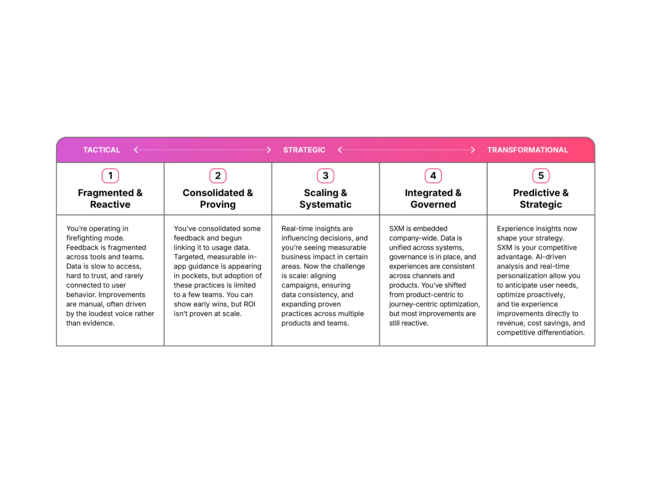Every customer, employee, and partner experiences your business through software. In today’s world, every organization—no matter the industry—is a software company.
When those experiences work, they unlock growth, efficiency, and trust. But when they don’t, you feel it everywhere: Projects stall, employees find unauthorized workarounds, customers churn, and risk seeps in through shadow IT or non-compliant tools.
For years, enterprises had to guess how good their software experiences were. Is feature adoption too low? Is churn too high? How are you growing compared to others in your market, region, and size?
To give you a clear picture of your current state, what’s next, and the outcomes you can unlock, we built the Software Experience Management (SXM) Maturity Matrix.
It’s a consultative framework to help you:
- Identify where your capabilities sit today across data, insight, action, and governance
- Pinpoint the biggest opportunities for improvement
- Build the business case for change with measurable ROI
5 stages of SXM maturity, at a glance
The SXM Maturity Matrix describes the progression that companies follow as they improve how they manage and optimize software experiences.
While every company’s path is unique, the stages are consistent: You move from firefighting and scattered tools to coordinated, AI-powered insight and action, with measurable business outcomes at every step. Here’s how we’ve defined the five stages of SXM maturity.

Stage 1: Reactive
You’re operating in firefighting mode. Feedback is fragmented across tools and teams. Data is slow to access, hard to trust, and rarely connected to user behavior. Improvements are manual, often driven by the loudest voice rather than evidence.
If this is where you are, consider:
- Centralizing feedback collection, like implementing basic tools to gather user feedback in one place instead of scattered emails, slacks, and tickets.
- Establishing baseline performance metrics. Are there 3-5 key user experience (UX) metrics that everyone can agree on and track consistently?
- Creating cross-team visibility. Set up simple dashboards so product, CS, revenue, marketing, and IT teams can access your UX data.
- Training 2-3 internal champions per team to advocate for more data-driven software experience decisions.
- Documenting current pain points by mapping out where users struggle most to prioritize your first improvement efforts.
Stage 2: Proving
You’ve consolidated some feedback and begun linking it to usage data. Targeted, measurable in-app guidance is appearing in pockets, but adoption of these practices is limited to a few teams. You can show early wins, but you aren’t proving ROI at scale.
If this is where you are, consider:
- Linking feedback to user behavior. Connect what users say (surveys, support tickets) with what they do (usage analytics, clickstreams).
- Deploying targeted guidance. Create in-app help for your highest-impact user journeys to prove ROI.
- Standardizing measurement practices. Ensure all teams measure user success the same way.
- Expanding pilot programs. Take successful initiatives from one team and replicate them in 2-3 other areas.
- Documenting ROI from early wins. Build business cases showing how experience improvements impact key metrics.
Stage 3: Scaling
Real-time insights are influencing decisions, and you’re seeing measurable business impact in certain areas. Now the challenge is to scale that impact: aligning campaigns, ensuring data consistency, and expanding proven practices across multiple products and teams.
If this is where you are, consider:
- Aligning roadmaps across teams. Coordinate experience improvements between product, marketing, and support teams.
- Standardizing data definitions. Ensure "user activation," "engagement," and other key terms mean the same thing everywhere.
- Deploying self-service analytics. Enable teams to answer their own questions without waiting for data requests.
- Creating shared OKRs. Set company-wide objectives that require teams to collaborate on user experience.
- Integrating platforms across systems. Connect your feedback tools, analytics, and guidance platforms for unified insights.
Stage 4: Integrated
SXM is embedded company-wide. Data is unified across systems, governance is in place, and experiences are consistent across channels and products. You’ve shifted from product-centric to journey-centric optimization, but most improvements are still reactive.
If this is where you are, consider:
- Establishing predictive capabilities. Use AI and machine learning to anticipate user needs before they become problems.
- Creating journey-centric optimization. Optimize complete user journeys across multiple products/touchpoints, not just individual features.
- Deploying advanced personalization. Tailor experiences in real-time based on user behavior, preferences, and context.
- Building a Center of Excellence. Create a dedicated team/function responsible for SXM strategy and governance across the organization.
- Integrating with business strategy. Ensure experience insights directly inform product roadmaps, pricing, and go-to-market decisions.
Stage 5: Predictive
Experiential insights now shape your strategy. SXM is your competitive advantage. AI-driven analysis and real-time personalization allow you to anticipate user needs, optimize proactively, and tie experience improvements directly to revenue, cost savings, and competitive differentiation.
If this is where you are, consider:
- Scaling AI-powered insights. Deploy machine learning across all touchpoints to continuously optimize experiences.
- Expanding ecosystem integration. Extend SXM practices to partners, vendors, and third-party integrations.
- Driving strategic innovation. Use experience insights to identify new product opportunities and market positioning.
- Establishing thought leadership. Share your SXM expertise externally to attract talent and establish competitive moats.
- Building next-generation capabilities. Invest in emerging technologies (AR/VR, voice interfaces, etc.) to maintain experience leadership.
Ready to see where you stand?
Take our 5-minute SXM Maturity Assessment to get personalized guidance on improving software experiences.
![[object Object]](https://cdn.builder.io/api/v1/image/assets%2F6a96e08774184353b3aa88032e406411%2F39f3ccde352b460cbf348ccc952054cd?format=webp)


